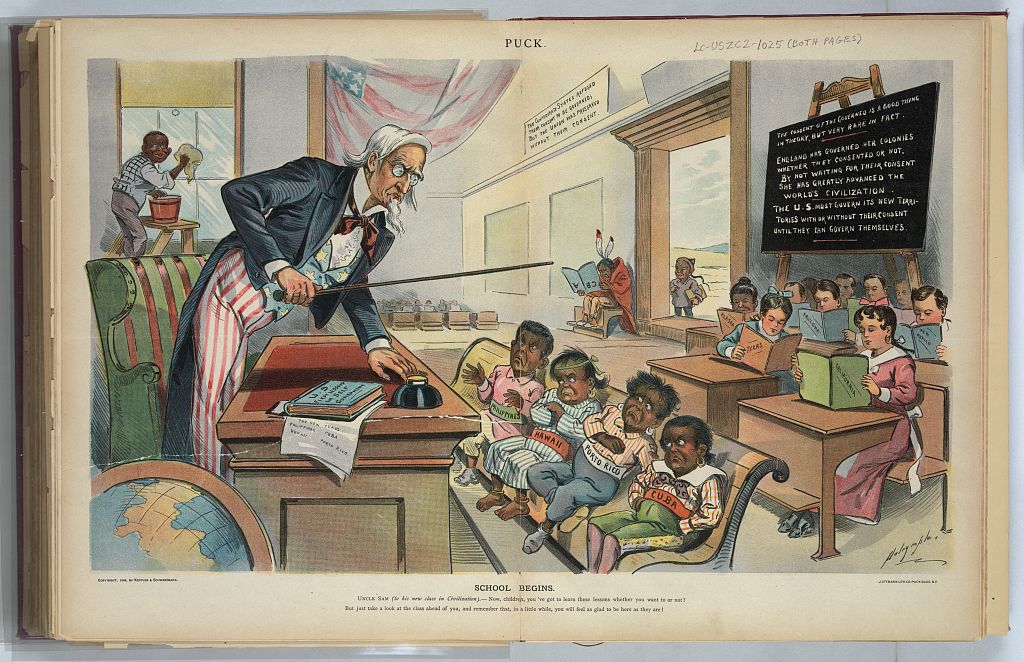As the next phase in the lesson plan for the 1898 Political Cartoons project, I have been creating a Zoom-In Inquiry activity, based on a lesson plan created by Joe Jelen (Northwood High School), published on teachinghistory.org. This introductory section will be designed to start leading students to a path of inquiry by doing a close reading of primary sources. This introductory portion of the lesson will include instructions on how to make a Zoom-In Inquiry slide show, with the goal of instructors and students to be able to create a similar product.
When it came to selecting the right image for this activity, I must admit, I struggled a little, as I needed to make sure that it contains enough details to draw historical questions from learners and get them engaged early on in the lesson. After a careful selection process, I have decided to go with the political cartoon “School Begins”, published by Puck Magazine in 1899. It is a primary source that is rich and complex in content, and encapsulates the persuasive power that these 1898 cartoons had in shaping American public opinion and perceptions of the Caribbean.

With its many cultural and historical meanings assigned in this image, and the combination of graphical and textual elements present, “School Begins” would be the appropriate item to begin the process of examining and interpreting a difficult primary source. Instructors using this Zoom-In Inquiry activity would help their learners develop the ability to “read” complex representations. The plan is to present a small portion of the image and pose initial observation questions that will engage their curiosity, such as: What do you see? Describe who/what you see in this image.
As they transition to more complete sections of the image, instructors can guide students into reading a gradual complex situation. They can introduce students to unfamiliar terms (e.g. irony, symbology, democracy, civilization) and historical content (e.g. U.S. imperialism, 1898 journalism), train them on taking relevant notes and asking deeper historical questions that will walk them through understanding the “bigger picture.” The presentation will then transition into more interpretive questions, like: When do you think this cartoon was created? What is happening in this image? Why do you think the characters you see are depicted in this fashion? What or who do you think you’ll see next? Why makes you believe that?
Each “reading”–or progression of slides–generates an iterative, dialogical process that would inform and modify learners’ assessment of what they are discovering. This re-reading provides the venue for students to rehearse interpretation of what is becoming evident to them, forming more sophisticated historical questions along the way that helps them support their arguments and explanations. At this point, the instructor could pose more evaluative questions, such as: Has your perception of the cartoon changed as you progressively see more of it? What is the cartoonist trying to convey? Who do you think is the audience? What questions do you have?
By the time the whole image of “School Begins” is revealed, the instructor can ask the “big picture” questions: What does this cartoon say about Puerto Ricans, Cubans? What does it say about other cultures (e.g. Hawaiians, Blacks, Native Americans, and Asians? What does it say about White students? What does it say about the relationship between these different cultural groups? Based on this image, how can you explain the impact of U.S. imperialism on Caribbean populations? What do you think is the impact this cartoon has on American imaginings of the Caribbean? Short-term impact? Long-term impact?
This activity will transition into the next part of the lesson, which will be to read Frederich Gleach’s article: “Images of Empire: Popular Representations of the 1898 War. This secondary source introduces students to techniques for reading 1898 political cartoons in order to analyze the ways in which political cartoons helped Americans construct cultural realities of Caribbean places and peoples. After the reading, they will study a small selection of images, along with complementary primary sources of the same era that will help them to further decode the meanings produced by these cartoons. More on that soon…